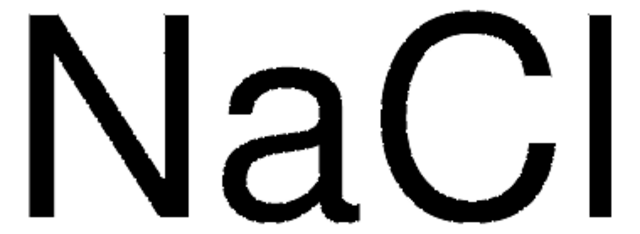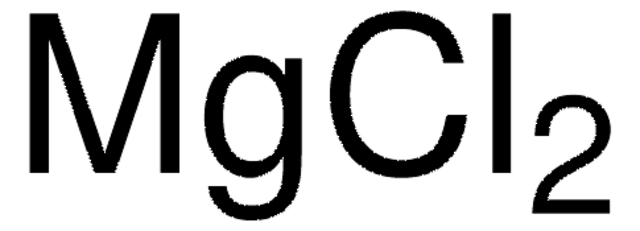P9541
Kaliumchlorid
for molecular biology, ≥99.0%
Synonym(e):
KCl
About This Item
Empfohlene Produkte
Qualität
for molecular biology
Qualitätsniveau
Assay
≥99.0%
Form
powder
mp (Schmelzpunkt)
770 °C (lit.)
Dichte
1.98 g/mL at 25 °C (lit.)
Kationenspuren
Fe: ≤3 ppm
heavy metals (as Pb): ≤5 ppm
Fremdaktivität
DNAse (exonuclease), NICKase (endonuclease), RNAse, and protease, none detected
SMILES String
[Cl-].[K+]
InChI
1S/ClH.K/h1H;/q;+1/p-1
InChIKey
WCUXLLCKKVVCTQ-UHFFFAOYSA-M
Suchen Sie nach ähnlichen Produkten? Aufrufen Leitfaden zum Produktvergleich
Verwandte Kategorien
Allgemeine Beschreibung
Anwendung
- als Bestandteil des Danieau-Mediums sowie bei der Herstellung von phosphatgepufferter Kochsalzlösung
- bei der Herstellung von Elektrolytlösung für elektrochemische Impedanzspektroskopie und zyklische Voltammetrie-Messungen
- als Bestandteil einer HEPES-(4-(2-Hydroxyethyl)-1-piperazinethansulfonsäure)-gepufferten Tyrode-Lösung
WGK
WGK 1
Flammpunkt (°F)
Not applicable
Flammpunkt (°C)
Not applicable
Persönliche Schutzausrüstung
Eyeshields, Gloves, type N95 (US)
Analysenzertifikate (COA)
Suchen Sie nach Analysenzertifikate (COA), indem Sie die Lot-/Chargennummer des Produkts eingeben. Lot- und Chargennummern sind auf dem Produktetikett hinter den Wörtern ‘Lot’ oder ‘Batch’ (Lot oder Charge) zu finden.
Besitzen Sie dieses Produkt bereits?
In der Dokumentenbibliothek finden Sie die Dokumentation zu den Produkten, die Sie kürzlich erworben haben.
Kunden haben sich ebenfalls angesehen
Protokolle
TE Buffer; Elution Buffer; 10x Ligation Buffer; 0.5 M PIPES Buffer; Inoue Transformation Buffer
In Situ Hybridization of Whole-Mount Mouse Embryos with RNA Probes: Hybridization, Washes, and Histochemistry. This is a protocol describing how to perform in situ hybridization on whole mouse embryos. Here we describe the hybridization procedure, and the localization of the DIG-labeled RNA using a conjugate of anti-DIG Fab antibody and calf intestinal alkaline phosphatase. Enzyme activity of the reporter is detected by a color reaction, resulting in the formation of a water-insoluble purple/blue precipitate. Manipulating the Mouse Embryo - Third Edition
Unser Team von Wissenschaftlern verfügt über Erfahrung in allen Forschungsbereichen einschließlich Life Science, Materialwissenschaften, chemischer Synthese, Chromatographie, Analytik und vielen mehr..
Setzen Sie sich mit dem technischen Dienst in Verbindung.




